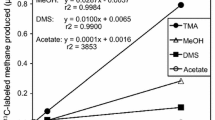Abstract
Desulfobacter sp. (Strain 3ac10), an acetate-utilizing sulphatereducing bacteria, was added to sterile marine pore water spiked with 14C-acetate, and changes in both the natural acetate pool and the added 14C-acetate were measured over time. Initially, both the added 14C-acetate and the chemically measured acetate were rapidly mineralized, but then the rate of removal decreased and a significant amount (approximately 20%) of both 14C-acetate and chemically measured acetate remained unmetabolised. In a replicate experiment, approximately 50% of the acetate was not metabolised. Kinetic analysis of the data indicated that there were two pools of acetate in the original pore water, a biologically available pool (which is rapidly metabolised) and a recalcitrant pool (which is only very slowly metabolised). Addition of 14C-acetate after the biologically available acetate had been removed resulted in rapid removal of the added acetate but no change in the recalcitrant acetate pool. The implications of this data to radiolabelled techniques of measuring in situ acetate turnover are discussed.
Similar content being viewed by others
Literature cited
Ansbaek, J. and T. H. Blackburn: A method for the analysis of acetate turnover in a coastal marine sediment. Microb. Ecol. 5, 253–264 (1980)
Balba, M. T. and D. B. Nedwell: Microbial metabolism of acetate, propionate and butyrate in anoxic sediment from Colne Point Saltmarsh, Essex, U.K. J. gen. Microbiol. 128, 1415–1422 (1982)
Banat, I. M., E. B. Lindström, D. B. Nedwell and M. T. Balba: Evidence for coexistence of two distinct functional groups of sulfate-reducing bacteria in salt marsh sediment. Appl. envirl Microbiol. 42, 985–992 (1981)
Burnison, B. K. and R. Y. Morita: heterotrophic potential for amino acid uptake in a naturally eutrophic lake. Appl. Microbiol. 27, 488–495 (1974)
Christensen, D. and T. H. Blackburn: Turnover of tracer (14C, 3H labelled) alanine in inshore marine sediments. Mar. Biol. 58, 97–103 (1980)
Christensen, D. and T. H. Blackburn: Turnover of 14C-labelled acetate in marine sediments. Mar. Biol. 71, 113–119 (1982)
Dawson, R. and K. Gocke: Heterotrophic activity in comparison to the free amino acid concentrations in Baltic sea water samples. Oceanol. Acta 1, 45–54 (1978)
Fenchel, T. M. and T. H. Blackburn: Bacteria and mineral cycling, 255 pp. London: Academic Press 1979
Gocke, K., R. Dawson and G. Liebezeit: Availability of dissolved free glucose to heterotrophic microorganisms. Mar. Biol. 62, 209–216 (1981)
Hungate, R. E.: The rumen and its microbes, 533 pp. New York and London: Academic Press 1966
Jannasch, H. W. and C. O. Wirsen: Microbiol activities in undecompressed and decompressed deep-seawater samples. Appl. envirl Microbiol. 43, 1116–1124 (1982)
Jeris, J. S. and P. L. McCarty: The biochemistry of methane formation using 14C tracers. J. Wat. Pollut. Control Fed. 37, 178–192 (1965)
Lovley, D. R. and M. J. Klug: Intermediary metabolism of organic matter in the sediments of a eutrophic lake. Appl. envirl Microbiol. 43, 552–560 (1982)
Parkes, R. J. and J. Taylor: Analysis of volatile fatty acids by ionexclusion chromatography, with special reference to marine pore water. Mar. Biol. 77, 113–118 (1981)
Pearson, T. H.: The Loch Eil project: introduction and rationale. J. exp.mar. Biol. Ecol. 55, 93–102 (1981)
Robbins, J. A. and J. Gustinis: A squeezer for efficient extraction of pore water from small volumes of anoxic sediment. Limnol. Oceanogr. 21, 905–909 (1976)
Snedecor, G. W. and W. G. Cochran: Statistical methods, 6th ed. 593 pp. Ames, Iowa: Iowa State University Press 1967
Sørensen, J., D. Christensen and B. B. Jørgensen: Volatile fatty acids and hydrogen as substrates for sulphate reducing bacteria in anaerobic marine sediment. Appl. envirl Microbial. 42, 5–11 (1981)
Taylor, J. and R. J. Parkes: The cellular fatty acids of the sulphate-reducing bacteria, Desulfobacter sp., Desulfobulbus sp. and Desulfovibrio desulfuricans. J. gen. Microbiol. 129, 3303–3309 (1983)
Taylor, J. and R. J. Parkes: The application of cellular fatty acids to identify different types of sulphate-reducing bacteria within marine sediment systems.(In preparation) (1984)
Widdel, F. and N. Pfennig:Studies on dissimilatory sulfatereducing bacteria that decompose fatty acids. I. Isolation of new sulfate-reducing bacteria enriched with acetate from saline environments. Description of Desulfobacter postgatei. gen. nov., sp. nov. Archs Microbiol. 129, 395–400 (1981)
Winfrey, M. R. and D. M. Ward: Substrates for sulphate-reduction and methane production in intertidal sediments. Appl. envirl Microbiol. 45, 193–199 (1983)
Wolfe, R. S. and I. J. Higgins: Microbial biochemistry of methane —a study of contrasts. In: International review of biochemistry, Vol. 21.pp 260–280.Ed. by J. R. Quale. Baltimore:University Park Press1979
Author information
Authors and Affiliations
Additional information
Communicated by J. Mauchline, Oban
Rights and permissions
About this article
Cite this article
Parkes, R.J., Taylor, J. & Jørck-Ramberg, D. Demonstration, using Desulfobacter sp., of two pools of acetate with different biological availabilities in marine pore water. Mar. Biol. 83, 271–276 (1984). https://doi.org/10.1007/BF00397459
Accepted:
Issue Date:
DOI: https://doi.org/10.1007/BF00397459




